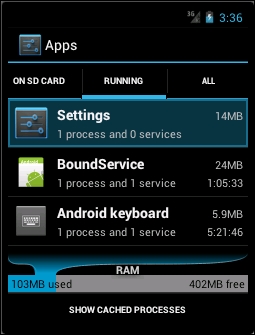Bound services are services that allow users to bind themselves to them and ask for information. The examples of bound services can be seen in the location, and sensor services are natively run on modern Android phones. The principal addition of the bound service in comparison to the started service is its ability to accept clients' requests. The clients bind themselves to services using an IBinder instance. In this recipe, we will see how to implement a bound service and its Binder.
To follow this recipe, create a new project in the services solution that we created earlier and name it BoundService.
Let's have a look at steps required to implement a bound service:
- Create a new class in the
BoundServiceproject and name itMyBoundService. As this class is the service, we have to add the[Service](and subclassService) attribute and theOnStartCommand()method, as seen in the previous recipe. Additionally,MyBoundServicecontains a reference to anIBinderobject; override theOnBind()method, shown as follows:[Service] [IntentFilter(new String[]{"ca.services.MyBoundService"})] public class MyBoundService : Service { IBinder _myBinder = null; public String SayHello() { return "HelloWorld"; } public override StartCommandResult OnStartCommand (Android.Content.Intentintent, StartCommandFlagsflags, intstartId) { Log.Debug ("MyBoundService", "StartCommandResult"); this._myBinder = new MyBoundServiceBinder (this); return StartCommandResult.NotSticky; } public override IBinder OnBind (Intent intent) { Log.Debug ("MyBoundService", "NewClient"); return _myBinder; } } - Create a new class named
MyBoundServiceBinderthat extends theBinderclass and owns a reference toMyBoundService. The constructor ofMyBoundServiceBindertakesMyBoundServiceas an argument and populates the private reference with it. Finally,MyBoundServiceBinderhas a getter that returns theMyBoundServicereference:public class MyBoundServiceBinder : Binder { private MyBoundService _myBoundService; public MyBoundService BoundService { get{return _myBoundService;} } public MyBoundServiceBinder (MyBoundService_myBoundService) { this._myBoundService = _myBoundService; Log.Debug ("MyBoundServiceBinder", "NewBinder"); } } - Add a reference to
MyBoundServiceBinderin your main activity the same as anIsBoundBoolean. Also, add aconsumerService()method, shown as follows:[Activity(Label="BoundService",MainLauncher=true)] public class MainActivity : Activity { private MyBoundServiceBinder _myBinder; private Boolean _IsBound; public MyBoundServiceBinder Binder { get{ return_myBinder; } set{ _myBinder=value; } } public Boolean IsBound { get{ return_IsBound; } set{ _IsBound=value; } } public void ConsumeService() { Log.Debug ("MainActivity",_myBinder.BoundService.SayHello ()); } } - Create a new class named
MyBoundServiceConnectionthat implements theIServiceConnectioninterface and owns a reference toMyBoundService. TheMyBoundServiceConnectionclass implements theOnServiceConnected()andOnServiceDisconnected()methods belonging to theIServiceConnectioninterface and contains a reference to the main activity:publicclassMyBoundServiceConnection:Java.Lang.Object,IServiceConnection { MainActivity _myActivity; public MyBoundServiceConnection (MainActivity activity) { this._myActivity = activity; } public void OnServiceConnected (ComponentName name,IBinder service) { Log.Debug ("MyBoundServiceConnection", "IncomingConnection"); var boundServiceBinder = service asMyBoundServiceBinder; if (boundServiceBinder != null) { _myActivity.Binder = boundServiceBinder; _myActivity.isBinded = true; _myActivity.consumeService (); } } public void OnServiceDisconnected (ComponentName name) { _myActivity.isBinded = false; } } - Bind your
MainActivityto theMyBoundServiceservice using theBindService()method that takesIntentas arguments, an implementation ofIServiceConnection, and aBindflag:protected override void OnCreate(Bundle bundle) { base.OnCreate (bundle); Intent myBoundServiceIntent = new Intent("ca.services.MyBoundService"); StartService (myBoundServiceIntent); cnx = new MyBoundServiceConnection (this); BindService (myBoundServiceIntent, cnx, Bind.AutoCreate); } - Run your application. The following lines will appear in the console:
[MyBoundService] StartCommandResult [MyBoundServiceBinder] New Binder [MyBoundService] New Client [MyBoundServiceConnection] Incoming Connection [MainActivity] Hello World
In order to understand how it works, we first need to understand the sequence in which the objects interact with each other. The following figure depicts a simplified UML sequence diagram of the collaborations between the objects:

First, in the OnCreate() method, we make a call to the StartService() method in the StartService assembly. This assembly holds code and Xamarin. Android will take care of creating MyBoundService and triggering a call to the OnStartCommand()method. Note that there is no message from MyBoundService to MainActivity to inform MainActivity that
MyBoundService has started correctly. Indeed, the StartService() method triggers the start and doesn't wait for an acknowledgment from MyBoundService. Then, MainActivity obtains a new MyBoundServiceConnection and asks the BindingAssembly to bind the MyBoundService service. The BindingAssembly will trigger the OnBind() method of MyBoundService and the OnBindService() method of MyBoundServiceConnection when the binding gets completed. Finally, MyBoundServiceConnection will invoke the ConsumeService() method, and the MainActivity class will consume MyBoundService.SayHello() method.
Note
You may wonder why we don't call MyBoundService.SayHello() method directly after BindService and remove the ConsumeService() method? The response is simple, we don't know how long it will take for the service to bound effectively, and MyBoundServiceBinder may be null if we don't wait long enough. We can have an infinite while(!IsBound){} in order to wait for the Boolean to be true. However, the current solution avoids a potential infinite loop and stays simple by avoiding the use of Thread wait and join.
To summarize, clients use MyBoundServiceBinder to obtain a reference of MyBoundService, and call a public method on the service. MyBoundServiceBinder gets populated after the asynchronous call to the BindingAssembly that triggers the OnBind() and OnBindService() methods. Once the OnBindService() method has been executed, we can be sure that the reference to MyBoundServiceBinder has been populated, and we can start using the service.
If you want to be sure that your application is running your services, you can simply access the running application on your phone (or emulator) under Settings | Apps | Running, and check how many services are running. In the following picture, we can see one service and one process for the BoundService application:

